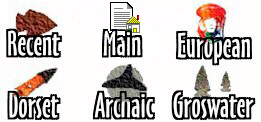![[Header]](resour.jpg)
![[Header]](resour.jpg)
Marine AnimalsSeals
The people who came to Port au Choix did so because of the rich resources that were available at specific times of the year. For the Maritime Archaic Indians seals were an important resource. The harp seal in particular was an essential source of food, waterproof clothing, fuel and shelter. The harp seal spends its summer in Greenland and its winters in the Gulf of St. Lawrence and off the northern coast of Newfoundland. During February and March the harp seal whelps (bears its young) on the pack ice at one of the whelping and mating grounds. There are two located in Newfoundland; one is off northern Newfoundland, the other is in the Gulf of St. Lawrence. Nearly a half million pups are born each year, and they grow to a weight of 136-181 kg.The Strait of Belle Isle is one of two routes for the harp seal's seasonal trek between the Gulf of St. Lawrence and Greenland. In December, the seals pass Port au Choix on their southward journey to the Gulf, in front of the icepack. In the spring they head north with their young to their summer home waters, passing Port au Choix during April and May. There is some evidence to suggest that smaller breeding grounds for the harp seal exist in the Strait of Belle Isle, not far from Port au Choix.
Whales
Whales were also an important resource for the people that came to this area. In the 1500s, the Basque fishermen set up a whaling factory just across the Straits at Red Bay, Labrador. It is believed that they killed and processed 20,000 Right and Humpback whales, giving Red Bay the distinction of being the "Whaling Capital of the World" at that time. It is not known whether prehistoric peoples actually hunted the whales or whether they exploited the carcasses of beached whales.
Cod and Salmon
Even though cod has played a major role in Newfoundland's settlement and economy for the past 500 years, there is little evidence to suggest that prehistoric people put much emphasis on cod. Salmon, however, may have been a more valuable resource. In the area off Point Riche from June to August, salmon swim rivers upstream to spawn and return to the sea by late fall. Leisters that would have been used for shallow water fishing were found in some of the burials at the Maritime Archaic Indian cemetery.
Land Animals
Caribou
One of three caribou herds located in Newfoundland is found on the Northern Peninsula close to Port au Choix. Caribou was particularly important to the Maritime Archaic Indians. Many tools found at the cemetery were made of caribou bone. Since they can weigh up to 272 kg, caribou can provide a lot of meat. Its antlers were also used for making tools, and the skins have excellent insulating properties for use as clothing because of their hollow hair.
Beavers
Beaver was hunted for food, furs and tool-making. The skins are in their best condition during the month of October. Beaver incisors (teeth) made very good carving tools when hafted on a handle. Many beaver incisors were found at the Maritime Archaic Indian cemetery.
Ducks, Gulls and Auks
Prehistoric duck hunting sites have been found located next to modern-day bird blinds on the Point Riche Peninsula, in areas where there is open water year round. Migratory ducks would congregate in the area to feed, thereby becoming easy prey for prehistoric and modern-day hunters. A wide range of gulls and ducks are represented at the Maritime Archaic Indian cemetery and other prehistoric sites in Port au Choix. One group of ten graves at the cemetery contained a total of 238 bills of the now extinct Great Auk.
